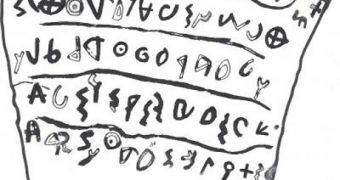Scientists at the University of Haifa, led by Professor Gershon Galil, announce that they managed to decipher some of the oldest Hebrew biblical inscriptions available. The work sheds new light on the period in which the Holy Book was written, and also demonstrates that the tablet Galil analyzed is the oldest biblical scripture in existence. The team was made up of experts who worked at the Department of Biblical Studies at the university.
The translation “indicates that the Kingdom of Israel already existed in the 10th century BCE and that at least some of the biblical texts were written hundreds of years before the dates presented in current research,” Galil reveals. According to the expert, the trapezoidal tablet that contains the texts the team analyzed dates back to the time of King David's reign. Another significant piece of information that the translation provided refers to the fact that many of the writings presented in the Bible are in fact several centuries older than current wisdom has it, and also that the Kingdom of Israel existed at the time of their writing.
The tablet itself is a trapezoidal pottery shard, which has been inscribed with ink. Its measurements are 15 by 16.5 centimeters, and it was discovered more than one and a half years ago. In charge of the excavations that revealed the piece of scripture was Professor Yosef Garfinkel, who was working at a site called Khirbet Qeiyafa, near the Elah valley. Upon its discoveries, opinions were divided on whether the language used was Hebrew or some local dialect, but Galil's work demonstrates that indeed the tablets are inscribed in Hebrew, which attests to their authenticity and old age.
“This text is a social statement, relating to slaves, widows and orphans. It uses verbs that were characteristic of Hebrew, such as asah ('did') and avad ('worked'), which were rarely used in other regional languages. Particular words that appear in the text, such as almanah ('widow') are specific to Hebrew and are written differently in other local languages,” Galil says of the tablets.
“The content itself was also unfamiliar to all the cultures in the region besides the Hebrew society: The present inscription provides social elements similar to those found in the biblical prophecies and very different from prophecies written by other cultures postulating glorification of the gods and taking care of their physical needs,” he adds. The new work stands against established knowledge, which has it that the Hebrews were not able to write so far back in time. It also shows that the composition of the Bible is not directly related to the time when Jesus Christ is said to have lived.
“It can now be maintained that it was highly reasonable that during the 10th century BCE, during the reign of King David, there were scribes in Israel who were able to write literary texts and complex historiographies such as the books of Judges and Samuel,” Galil says.
English translation of the deciphered text: 1' you shall not do [it], but worship the [Lord]. 2' Judge the sla[ve] and the wid[ow] / Judge the orph[an] 3' [and] the stranger. [Pl]ead for the infant / plead for the po[or and] 4' the widow. Rehabilitate [the poor] at the hands of the king. 5' Protect the po[or and] the slave / [supp]ort the stranger.

 14 DAY TRIAL //
14 DAY TRIAL //